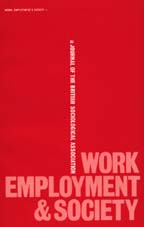Crossref Citations
This article has been cited by the following publications. This list is generated based on data provided by
Crossref.
Crompton, Rosemary
2002.
Employment, flexible working and the family.
The British Journal of Sociology,
Vol. 53,
Issue. 4,
p.
537.
Morrell, Robert
Posel, Dorrit
and
Devey, Richard
2003.
Counting Fathers in South Africa: Issues of Definition, Methodology and Policy.
Social Dynamics,
Vol. 29,
Issue. 2,
p.
73.
Lewis, Suzan
Rapoport, Rhona
and
Gambles, Richenda
2003.
Reflections on the integration of paid work and the rest of life.
Journal of Managerial Psychology,
Vol. 18,
Issue. 8,
p.
824.
Morehead, Alison
2003.
Managing Flexible Working Time Arrangements: Negotiations between Mothers and Managers in a Canberra Hospital.
Labour & Industry: a journal of the social and economic relations of work,
Vol. 14,
Issue. 1,
p.
91.
Halfacree, Keith
2004.
Untying migration completely: ce‐gendering or radical transformation?.
Journal of Ethnic and Migration Studies,
Vol. 30,
Issue. 2,
p.
397.
Meriläinen, Susan
Tienari, Janne
Thomas, Robyn
and
Davies, Annette
2004.
Management Consultant Talk: A Cross-Cultural Comparison of Normalizing Discourse and Resistance.
Organization,
Vol. 11,
Issue. 4,
p.
539.
Baldock, John
and
Hadlow, Jan
2004.
Managing the Family: Productivity, Scheduling and the Male Veto.
Social Policy & Administration,
Vol. 38,
Issue. 6,
p.
706.
Bond, Sue
2004.
Organisational culture and work‐life conflict in the UK.
International Journal of Sociology and Social Policy,
Vol. 24,
Issue. 12,
p.
1.
Smithson, Janet
Lewis, Suzan
Cooper, Cary
and
Dyer, Jackie
2004.
Flexible Working and the Gender Pay Gap in the Accountancy Profession.
Work, Employment and Society,
Vol. 18,
Issue. 1,
p.
115.
Olsen, Karen M.
and
Kalleberg, Arne L.
2004.
Non-Standard Work in Two Different Employment Regimes.
Work, Employment and Society,
Vol. 18,
Issue. 2,
p.
321.
2005.
Work‐Life Integration.
p.
159.
McDowell, Linda
2005.
Love, money, and gender divisions of labour: some critical reflections on welfare-to-work policies in the UK.
Journal of Economic Geography,
Vol. 5,
Issue. 3,
p.
365.
Doherty, Sean T.
2006.
Should we abandon activity type analysis? Redefining activities by their salient attributes.
Transportation,
Vol. 33,
Issue. 6,
p.
517.
2006.
The Myth of Work‒Life Balance.
p.
99.
Bygren, Magnus
and
Duvander, Ann‐Zofie
2006.
Parents’ Workplace Situation and Fathers’ Parental Leave Use.
Journal of Marriage and Family,
Vol. 68,
Issue. 2,
p.
363.
O'Brien, Margaret
Brandth, Berit
and
Kvande, Elin
2007.
FATHERS, WORK AND FAMILY LIFE.
Community, Work & Family,
Vol. 10,
Issue. 4,
p.
375.
Børve, Hege Eggen
2007.
Pregnant Bodies.
European Journal of Women's Studies,
Vol. 14,
Issue. 4,
p.
311.
Drew, Eileen
and
Daverth, Gwen
2007.
Negotiating Work/Life Balance : The Experience of Fathers and Mothers in Ireland.
Recherches sociologiques et anthropologiques,
Vol. 38,
Issue. 2,
p.
65.
Lappegård, Trude
2007.
Sosiologiske forklaringer på fruktbarhetsendring i Norge i nyere tid.
Sosiologisk tidsskrift,
Vol. 15,
Issue. 1,
p.
55.
Lewis, Suzan
Gambles, Richenda
and
Rapoport, Rhona
2007.
The constraints of a ‘work–life balance’ approach: an international perspective.
The International Journal of Human Resource Management,
Vol. 18,
Issue. 3,
p.
360.




